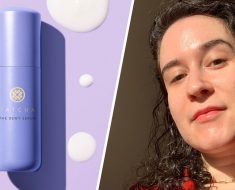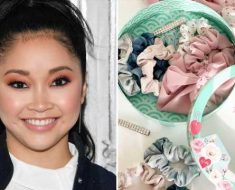In 2019, when some Black actors — including Natasha Rothwell, Gabrielle Union, and Tiffany Haddish — first started really speaking up in larger numbers about the frustrating hair and makeup experiences they've had on television and film sets, their stories rekindled some unpleasant memories for me.
From 2007 to 2011, I was a beauty editor at Glamour, and often invited to press events at salons where complimentary blowouts were on offer. But I usually declined the service: I knew very well that it was unlikely there would be a stylist available with the skills to work with my hair — I have a tightly coiled texture and it was natural, but at the time, I wore it straight. Occasionally, I would ask a publicist in advance if the salon could accommodate my texture, and the answer was always "of course!" Then I arrived for the appointment. I could always tell by the nervous smile of my assigned stylist as they walked toward me… they rarely had a Black client in their chair.
During those sessions, the stylist would do their best to project total confidence (which I could see right through). I would cope by making polite conversation to mask my deep discomfort. It was stressful sitting in that chair, hoping for the best, but quietly expecting the worst. I would think to myself, why on earth did I sign up for this? I guess I wanted to believe that maybe, just this once, I could get my hair done at a luxury salon for free and things would turn out okay.
Instead, those moments were awkward, the opposite of pampering and certainly not relaxing. I would have to gently instruct the professional behind me without offending them and then pretend to like the results. I never asked for a complicated style or cut — I just wanted a blowout. But there is an art to straightening natural hair and sadly, on more than one occasion, I left the salon with an embarrassing, poufy hairdo, when poufiness was not the goal.
I frequently opted out of the free makeup application offers, too. They often went more or less like the blowouts. In this case, I'd walk out with unflattering makeup because the makeup artist didn’t have the right shades for my brown skin tone or didn't know which eye shadow or lipstick colors would look best.
"I wanted to believe that maybe, just this once, I could get my hair done at a luxury salon."
It's no secret that mid-level beauty editors don't get paid huge salaries, but these complimentary services are one of the benefits that make up for that. It bothered me that although I was working my ass off, I was missing out on the perks that my lighter-skinned, wavier-haired colleagues enjoyed all the time. But at least I didn't have to worry about being photographed or filmed. I would just wipe off the makeup when I got home or redo my hair the next day. When I was at Glamour, Instagram hadn't blown up yet. If I were still in that job today, though, my grievances would be exacerbated by the fact that there's an expectation to post selfies after all these events.
Looking back, it saddens me that I accepted this as the status quo. I wish I had been more direct with publicists when turning down invitations and told them exactly why. I'm not convinced that calling them out would have changed anything then, but it would have felt better to me than stifling my resentment and allowing everyone to ignore the elephant in the room.
I'm sure I'm not the only Black woman who can relate to the actresses who have been vocal about the need for inclusivity behind the chair, who have felt the anger and frustration that come with having your face and hair in the hands of someone who's really not sure what to do with them. But obviously, the stakes are much higher for those who will then stand up and walk in front of a camera, whose images will be captured and eventually beamed in high-definition around the world.
Yet little has changed since #ActingWhileBlack was trending in 2019, since a slew of once-hidden stories came pouring out, like when Halle Berry admitted that she opted for her famous pixie cut as a result of experiences she had with industry stylists – not simply because it was chic. And talented women are still pushing for change. Last summer, Aisha Dee, a star of The Bold Type, wrote on Instagram that "it took three seasons to get someone in the hair department who knew how to work with textured hair."
"It took three seasons to get someone in the hair department who knew how to work with textured hair."
In a statement at the time, The Bold Type along with Freeform and Universal, said, "We applaud Aisha for raising her hand and starting conversations around these important issues. We look forward to continuing that dialogue and enacting positive change."
So when will comprehensive, lasting change finally come?
"I'm hoping and praying that things will get better as we make a full return to work [post-COVID]," says makeup artist Denise Tunnell, the background supervisor for makeup on Genius: Aretha, the National Geographic TV series starring Cynthia Erivo.
Tunnell, who is based in Atlanta (known as "the Hollywood of the South"), has been in the TV and film business for 22 years. "I've heard these stories throughout my career. Actresses would tell me about how they would have to go back to their trailers and change their makeup or do something a little bit different to their hair," she says. "I've heard of a really popular actress who, when she came to Atlanta to shoot a show, a white department head, sent her to [a makeup counter at] the mall for them to match her skin tone."
Incidents like the ones Tunnell describes are bound to keep happening until the on-set hair and makeup teams become as diverse as the casts they work with. "Now since the climate has changed and there are more African-Americans on shows, there are more people of color to do what's needed in the crews," says Los Angeles-based Emmy-nominated hairstylist Rhonda O'Neal. "I'm not saying that every Black person ought to do every Black person's hair, but [the actors] want more representation, and it's not there all the time."
Creating a more inclusive landscape is easier said than done, though, partly because the pool of talent used for movies and TV shows primarily comes from the labor unions — television and film productions must use them to stay in line with the employment rules that they're legally obligated to follow. "The producers do the hiring, but their hands are tied. If you pull somebody in who's not in the union, that's a red flag and it could be a fine," says O'Neal.
"Not everyone gets the privilege [of requesting their own stylist] — and not everyone asks for it."
Actors can put in requests to have their own makeup artist or hairstylist, but Tunell says, "not everyone gets the privilege and not everyone asks for it. Producers don't always want to spend extra money."
O'Neal is the hair craft president of the Make-Up Artists & Hairstylists Guild (IATSE Local 706) on the West Coast and sits on its board of trustees, and Atlanta-based Tunnell is a member of IATSE Local 798, a union for makeup artists and hairstylists on the East Coast. (IATSE stands for the International Alliance of Theatrical Stage Employees and represents many of the behind-the-scenes workers in the entertainment industry; the group includes more than 375 local unions.)
Both of these powerful beauty-focused unions require artists to complete a certain number of paid workdays on a film, television, or commercial set and provide documentation in order to apply for membership. Accumulating the necessary number of hours can be difficult without the right connections. In some cases, experience doing editorial and red-carpet work counts toward those hours; in many cases, it does not.
Hairstylist Lacy Redway, who works with Hollywood names like Tessa Thompson, Lucy Boynton, and Laura Harrier, wishes there was more flexibility in the hours that must be logged to earn union membership. "There are other ways to understand if someone is qualified to work on a movie set," she says. O'Neal says a lack of awareness about the union and how to join can also stand in the way. "When you have more people that are in the union that are Caucasian, those friends are gonna tell their friends. When you have, let's say, 10 percent African-American membership, only that 10 percent can go tell their friends about it," she says.
Amid last summer's reckoning on race in America, dozens of powerful forces in the beauty industry (from Ulta Beauty to Glossier to Allure) publicized their diversity numbers. The two IATSE unions did not, but they did issue a joint statement: "For too long, we have turned a blind eye to the need for our workspaces to represent all members of our society, and for all workers to have an equal opportunity to enter the entertainment industry," they said. "We can do better. We must do better. We will do better… To this end, we call for an immediate industry-wide discussion to begin to address these issues and change the culture of the arts community."
"Diverse stories lead to diverse productions, lead to diverse crews."
When I reached out to IATSE Local 706 for further comment, business representative Randy Sayer said that, in terms of membership numbers, he had been told that roughly 11 to 14 percent of the union's roster members are Black — but noted that the union does not keep records on the racial makeup of its membership so those numbers may not be accurate. Local 706 wasn't able to share an action plan that they've put in place to encourage more Black membership. I reached out to IATSE Local 798 for this story several times, through phone and email, and didn't receive a response.
Some beauty professionals are making their own action plans. O'Neal, for example, recently opened Beyond the Combs Academy. The school offers relationship-building opportunities for aspiring talent as well as training for hairstylists who want to learn how to work on all types of hair, especially texture hair. "Being the hair craft president of my union, I was pondering what I could do to bring more Black people in. I wanted to have an avenue to help prepare them to get into the union because I didn't have that," she explains. "For my first open house, I brought in the business rep for the union so that he could explain to my students what it takes to get in. Now they have the knowledge of how to go and get these hours."
But getting into the union doesn't necessarily guarantee a steady stream of employment. Hiring decisions are typically made by producers, and they often hire people they have worked with for years. O'Neal says maintaining strong connections with other artists in the union is a good place to start — they can be very helpful in bringing you on board new projects where you can connect directly with producers. Some progress is being made, but it's clear that the larger system of the entertainment industry is due for a shakeup.
"We all need to work together to see that diversity and inclusivity extends to the writers, showrunners, directors, producers, and above-the-line talent that make these 'hiring' decisions," says Sayer, who also stressed that the union is not the employer. "Diverse stories lead to diverse productions, lead to diverse crews." Sayer did not provide any details on what that collaboration might look or what programs might come from it.
And while it's important to foster more diversity on sets, hopefully, we're heading toward a world in which any hairstylist or makeup artist can work on any cast member. In order for that to happen, pros who lack the skills need to take charge of their own education. In reporting this story, one hairstylist recalled that the standard textbook used in American beauty schools, Milady, included only one chapter that's solely devoted to Black hair.
But Emily Featherston, director of corporate communications for Milady's parent company, said that information about natural and textured hair is included throughout nine chapters in the book, and noted their release in 2013 of a stand-alone curriculum dedicated to natural haircare and braiding. "We believe stylists should be prepared to work on all hair textures. Because of this, content on different hair types is integrated throughout the entire book rather than having defined sections or chapters for certain types of hair."
However, Featherston did acknowledge that there's still a need for Milady to step up their Black hair training. "We know we can do better, and we will. After gathering feedback from customers and holding diversity and inclusion panel discussions with stakeholders from across the beauty industry, we are integrating more textured hair content throughout our print and digital resources," she says. "Our revised 14th Edition of Standard Cosmetology will release later this year."
"You've got to update your skill sets to reflect the way that culturally we see hair right now."
Redway sees education as a constant, lifelong process: "Age on crews may vary, but artists working on big films typically have been in the union for some time – it's easier to break into the editorial space [than] it would be to break into the film industry. It is getting much easier to gain access with the need for more artists skilled in textured hair," she says. "That's not to say that [big film crews] don't understand what's current, but we should continually learn. You've got to update your skill sets to reflect the way that culturally we see hair right now. And if you can't do all textures you should always be willing to grow."
Tunnell has often seen white makeup department heads purchase piles of makeup for Black skin when they place an order for a show with Black cast members. "Because they really don't know [what they need]," she explains. "And the sad part is they don’t even have it in their kits. I know we all don't know everything, but for people who have been in this game for 15, 20 years, there are no excuses. Black or White, we all have to be educated."
Redway believes there are artists out there who are seeking more knowledge, "but some people are scared. We have this culture where it's one little mishap and you get penalized by your peers. Sometimes people are afraid to ask for help because they don't want to be shamed for not already knowing something."
One white hairstylist and makeup artist who has been proactive about educating herself is London-based Bethany Swan, who designed the hair and makeup looks for Michaela Coel's series I May Destroy You. Her formal training didn't include Black hair, which is as typical in the U.K. as it is in the U.S., so she made an effort to learn on the job and by taking classes. "I also practiced, practiced, and practiced some more. I am constantly learning," says Swan. "I have always felt that it's my responsibility to learn about all hair types and skin tones. The information and education opportunities were always out there, but finally, a long-awaited shift of representation on screen for many underrepresented ethnicities has arrived. Hair and makeup artists have to be diligent to ensure their skills are inclusive of all hair textures and skin tones."
"Hair and makeup artists have to be diligent to ensure their skills are inclusive of all hair textures and skin tones."
After decades in the business, hairstylist Tina Outen, who is white, is also working to strengthen her Black hair expertise. "The pandemic gave me so much time to concentrate on finessing all the techniques I watch my specialist team deliver with ease," says Outen. "I ordered six Afro dolly heads in various textures. I was ashamed to realize that these were my first dolly heads of color in 30 years. It should have been a part of my basic training right at the start."
Outen's hair coach is Aliyah Shields, a young Black hairstylist who assists Outen backstage at Fashion Week. Shields has been helping Outen learn things like braiding, sectioning, and how to do twists. Outen hopes to graduate from practice doll heads to real women's heads soon and she and Shields plan to show off Outen’s skills on Instagram after she's had more practice.
Perhaps Outen's eagerness to learn at this stage in her career is a sign that more industry vets will begin to go beyond listening to Black women's stories of painful on-set experiences. Maybe they'll also take a look in the mirror. And then take action. "Change is not comfortable," says Tunnell. "But we have to get to that point where we're willing to be uncomfortable until we get it right."
Source: Read Full Article





